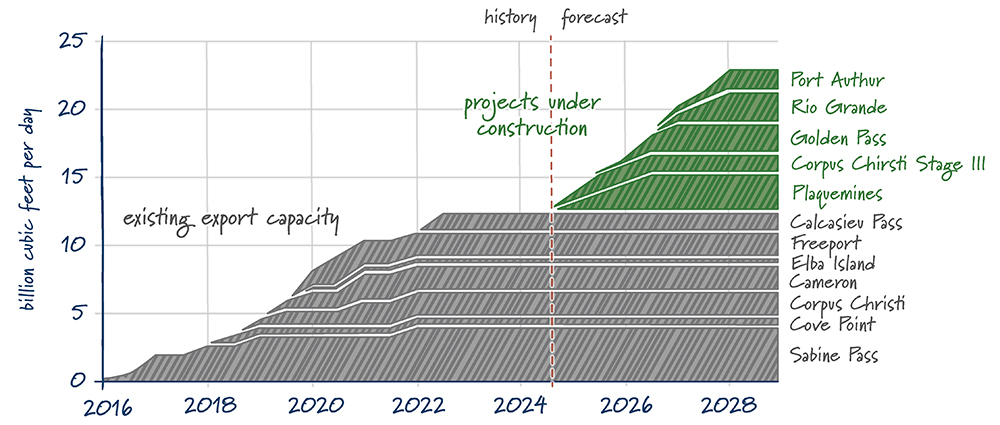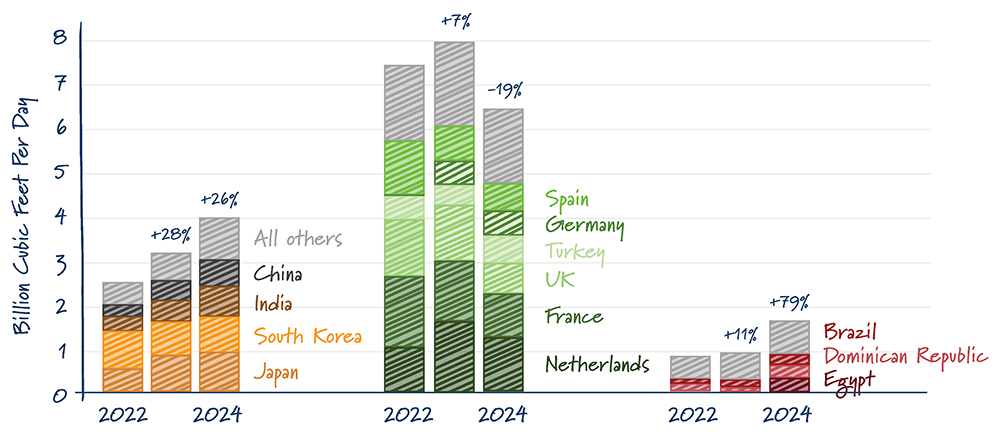Posted on May 8, 2025 by Matthew Mailloux
A renewed era of United States global energy leadership has arrived, and it is powered by liquified natural gas (LNG) today and can be quickly joined by a host of other clean energy technologies. The Trump administration has taken action in its first 100 days to demonstrate that LNG is once again a top energy priority, including recent executive orders and new approvals issued by the Department of Energy (DOE) to strengthen America’s ability to meet rising global demand, create new jobs, and project energy security abroad. As ClearPath has previewed before, where American gas goes, other clean energy technologies can follow.
In February 2025, the Trump administration approved the first new LNG export license–reversing the Biden administration’s politically motivated pause–granting authorization for the Commonwealth LNG project in Louisiana. This facility aims to export 9.5 million metric tons annually, targeting growing markets in Asia and Europe.
The push from the Administration is already accelerating private sector activity. The DOE extended export authorization for Golden Pass LNG, which is expected to begin shipments this year. Companies like Cheniere and Venture Global are rapidly scaling up export infrastructure across the Gulf Coast, including infusions of new capital investment to accelerate new projects. These projects demonstrate that the Administration’s approach to unleashing American energy is effective in delivering cleaner, reliable energy to global markets.
The Trump administration’s focus on cutting regulatory red tape, streamlining DOE export approvals, and unleashing private investment is setting the stage for even broader energy leadership. The Department of Energy’s work to accelerate LNG infrastructure dovetails with investments in critical minerals, advanced nuclear technology, next-generation geothermal, and carbon capture, creating an all-of-the-above energy advantage for the United States.
North America Liquefied Natural Gas Export Capacity By Projects (2026-2028)

These innovative energy technologies are well-positioned to follow the blueprint pioneered by LNG. Federal support for early-stage research combined with private-sector commercialization is rapidly advancing innovative technologies. These investments, supported by programs authorized by the Energy Act of 2020 and signed into law by President Trump funding from the bipartisan Infrastructure Investment and Jobs Act (IIJA) and reinforced by President Trump’s latest executive orders, are building an energy future anchored in American innovation.
LNG growth offers the opportunity to reassert America’s global leadership over foreign adversaries, and drive down global emissions as one of the most carbon efficient economies in the world. According to the U.S. Energy Information Administration (EIA), American LNG exports are projected to increase by 19% to 14.2 billion cubic feet per day (Bcf/d) in 2025 and climb further to 16.4 Bcf/d in 2026—continuing a growth trajectory that began in earnest less than a decade ago and cementing the U.S. as the world’s top LNG exporter.
Today, American LNG exports span 39 countries and counting. Long-term supply contracts are locking in demand well into the 2030s, providing partners worldwide with price stability and energy security. The U.S. is not just exporting molecules—it is exporting resilience, innovation, and a vision for cleaner growth.
Annual U.S. Liquified Natural Gas Exports By Destination (2022-2024)

To sustain this momentum, and broaden it to include other innovative clean technologies, the United States should fully leverage the tools of its export and development finance arsenal. The Export-Import Bank (EXIM) can play a vital role in deploying American LNG and clean energy technologies abroad by offering financing, insurance and loan guarantees for infrastructure projects. The U.S. International Development Finance Corporation (DFC) can similarly support these efforts through its diverse financial tools, fostering meaningful global energy partnerships. By providing robust support, these agencies can help U.S. companies effectively compete and secure long-term contracts in strategic energy markets like LNG.
EXIM and DFC can be instrumental in financing emerging innovations such as technologies alongside LNG, bundling projects that pair gas infrastructure with carbon capture, hydrogen, or advanced nuclear. For instance, EXIM financed nearly $3 billion for a project exporting LNG to Australia, which enhanced Australia’s energy security and supported 11,000 American jobs. This project highlights EXIM’s ability to finance large-scale LNG projects while producing a meaningful impact on U.S. employment. Similarly, DFC has played a key role in America’s energy leadership in helping Europe diversify from Russian gas and is actively investing in critical minerals projects in Brazil, as well as submitting letters of interest to support nuclear projects in multiple countries. This not only enhances U.S. economic competitiveness but embeds American values of transparency, market openness and environmental stewardship into the energy systems of tomorrow. As demand rises in Asia, Africa, and Eastern Europe, EXIM and DFC can ensure that American energy powers global development. Both agencies are due for reauthorization this Congress, offering significant opportunity to supercharge America’s international financing tools to achieve energy dominance in line with President Trump’s broader vision.
With targeted engagement, the U.S. can lead the world in both energy security and emissions reduction. Doing so will require the Trump administration to leverage all of the tools in its toolbox, including domestic energy incentives to boost production, and well-leveraged international authorities to promote American technology adoption abroad.
